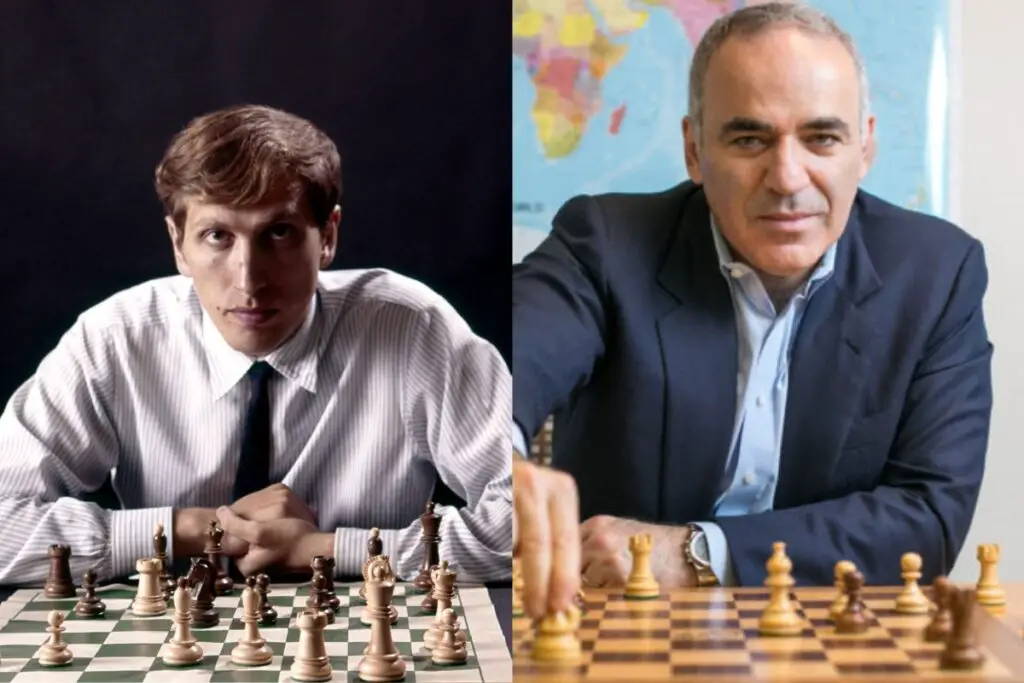Child prodigies were a rare sight in chess within the 1950s-1970s. Most of them decided not to pursue a career in the sport and faded into obscurity. Two names, however, grew to become some of the best to ever grace their lights on the sixty-four square game board.
Bobby Fischer was the only US Champion who had an 11-0 record, a 12-0 run in his World Championships, and matches that garnered global attention to the chess scene.
Garry Kasparov was the record holder for both the longest professional win-streak at 15, and the most number of Chess Oscars at 11. Today, we aim to answer who was better: Bobby Fischer or Garry Kasparov?
How Early Did They Reach Their First Peak Ranks?
Most chess legends started their careers early and became Grandmasters when they were mere teenagers. Fischer and Kasparov are no different.
Bobby Fischer
In July 1956, Fischer had his first major league stint as the US Junior Chess Champion in Philadelphia, becoming the competition’s youngest-known victor at 13. With the invitation of the US Chess Federation (USCF), he then participated in three major leagues in the next two years to solidify his place as US Champion and International Master.
Fischer reached Grandmaster at age 15 as he participated in the 1958 Interzonal in Portoroz, Moscow—the youngest in the modernized game’s history until Magnus Carlsen at age 13 and Abhimanyu Mishra at age 12.
He was also the youngest World Champion Candidate because of this event.
Garry Kasparov
Kasparov’s career start was also at age 13, as he emerged as the back-to-back Tbilisi Soviet Junior Champion in 1976-77 under the mentorship of Alexander Shakarov. He then became Master rank as he aced Minsk’s Sokolsky Memorial Tournament in 1978—which he recalls as his career’s turning point, as it gave him the confidence to eventually become world champion.
With the 1979 Russian Chess Federation making the mistake of enabling Juniors to enter a grandmaster tournament, Kasparov entered unranked and left with the win and a rating of 2595.
The rating earned him 15th place in the International Chess Federation (FIDE) world rankings, which helped him grasp the Grandmaster title with his 1980 World Junior Chess Championship—only at 17 years old!
What’s Their Playstyle Like?
In chess, a player’s style and character are evident in which board openings they like to employ. Here’s how each of them operated on the squares.
Bobby Fischer
Fischer was an aggressive and dominant opponent, as most of his openings made use of the ‘e4’ King’s pawn opening.
When playing White, Fischer likes going ‘e4’ into the traditional Sicilian Defense (1.e4 c5 2.Nf3 Nc6 3.d4 cxd4 4.Nxd4 Nf6) or his favorite Ruy Lopez open (1.e4 e5 2.Nf3 Nc6 3.Bb5 a6 4.Ba4 Nf6).
If neither was viable, Fischer liked the common Caro-Kann open (1.e4 c6 2.Nc3 d5 3.Nf3 Bg4 4.h3 Bxf3 5.Qxf3), wherein a lot of his wins came from punishing players who guessed his game plan incorrectly.
On the Black side, Bobby loves the King’s Indian Defense (1.d4 Nf6 2.c4 g6 3.Nc3 Bg7 4.e4 d6 5.Nf3) and the Sicilian Najdorf (1.e4 c5 2.d4 d6 3.Nf3 cxd4 4.Nxd4 Nf6 5.Nc3 a6), as it showcases his superior control of the central board exchange.
Garry Kasparov
Kasparov reportedly used to study Fischer’s patterns, so there are some similarities in their styles. He, too, uses Sicilian and Ruy Lopez when playing White, but with distinct variations.
Sicilian Defense: Accelerated Dragon – Maroczy Bind (1. e4 c5 2. Nf3 Nc6 3. d4 cxd4 4. Nd4 g6 5. c4) was for positional control with added options, while Ruy Lopez: Closed Variation (1. e4 e5 2. Nf3 Nc6 3. Bb5 a6 4. Ba4 Nf6) aims to pressure Black into pushing their pawns and overextending.
When on the opposite end, Garry employs countermeasures to the common openings, including Fischer’s famous offense.
He uses Najdorf as well, but his less common yet strangely effective wall is the King’s Indian-Samisch (1. d4 Nf6 2. c4 g6 3. Nc3 Bg7 4. e4 d6). Another opening he likes when playing Black is Sicilian Defense-Scheveningen (1. e4 c5 2. Nf3 d6 3. d4 cxd4 4. Nd4 Nf6 5. Nc3 a6).
Who Beat More Opponents?
The best way to determine who was the more victorious between the two would be their career stats. The following numbers are from 365chess.com’s database.
Fischer had a total of 954 games, with 546 wins, 284 draws, and 124 losses—a total percentage of 72.12 and an average rating of 2698 between his 1972 Iceland World Championship and his 1992 Saint Stefan tournaments.
Meanwhile, Kasparov had 2533 games, with 1371 wins, 948 draws, and 214 losses—with a 72.84 percentage and a rating of 2756 as of his latest Global Championship Tournament – Blitz format, July 2021 in Croatia.
This data would suggest Bobby decimated more opponents in individual matches, while Kasparov is fine with having numerous draws as long as the final tally is in his favor.
The Verdict: If They Face Each Other, Who Wins?
If dominant offense and experience were the basis, Fischer would be favored, thanks to his cold, calculative demeanor in play. He liked pushing his pieces into the opponent’s side of the board, forcing trades, and even willingly sacrificing his queen if it meant a more precarious position for the opposing player.
If defense and option-finding were the basis, it’s Kasparov’s expertise. Even Bobby would have trouble breaking through Garry’s wall of scrimmage, as the latter studied his systems and theories at an extensive length.
In totality, Kasparov has the slightest of advantages, given the knowledge and the number of matches he had under his belt even after leaving FIDE, whereas Fischer was in and out of the competitive scene.
Kasparov’s playstyle was also flexible and consistent, whereas Fischer’s play was prediction-reliant and highly volatile: brutal yet calculative on offense, but historically struggling on defense.
Sadly, the world of chess has been denied a single duel between its two former titans due to Fischer’s passing on January 2008.


